
11 ways to boost productivity with universal printing
“RDP printer redirection not working” is a common issue in Microsoft Remote Desktop Services (RDS) / Azure Virtual Desktop Environments.
Microsoft Remote Desktop Services (RDS) and Azure Virtual Desktop environments provide basic printing functionality.
However, a third-party solution like Parallels RAS can support more advanced printing scenarios.
For example, Parallels RAS printer redirection grants users access to all (or a subset) of their locally available printers.
It adds enterprise-ready printing capabilities, empowering organizations to deliver a unified user experience, streamlining workflows, and increasing productivity.
4 ways to implement remote desktop printer redirection
In order to allow a device — Android, iOS, or a Windows workstation — to print from within a remote session, administrators have to implement a form of printer redirection.
Printer redirection is a process where print jobs from a remote session, such as a published application or desktop, are sent to and printed on the user’s local printer.
There are several different ways to do this.
1. Automatic printing redirection
Printer redirection is automatic when the local printer uses a driver that is installed on the server.
- Pros: When you log on to a session on a terminal server/RDS, the local printer is detected, and a local queue is created on the server.
- Cons: Keeping the server updated with all the different printer drivers available on the clients is very complicated and time-consuming.
2. Manual printing redirection
Printers attached to the workstation can be manually redirected.
- Pros: Manually redirected.
- Cons: The process is quite complex, and the IT administrator has to adjust the configuration individually for each client.
3. Easy Print
Microsoft offers its Easy Print feature as a way to automate the process.
- Pros: The printers available to the client are mapped into the RDS session.
- Cons: Easy Printing is limited and does not permit dynamic updates to redirected printers.
4. Third-party solutions like Parallels RAS
With Parallels RAS, the universal printing drivers render the print job in a universal format on the server and send it to the client’s local printing subsystem.
From there, the local print spooler handles the printer-specific rendering of the print job with its locally installed printer driver.
- Pros: No need to install the printer drivers on the server. You can change the local printer without any effect on the server or printing capability. Performance is improved because the files transferred over the network are smaller, and changes on local printers are updated automatically in the remote session.
Comparing Parallels RAS Universal Printing vs Microsoft Remote Desktop Services (RDS) / Azure Virtual Desktop
This chart covers the main printing capabilities that Parallels RAS provides out of the box compared to Microsoft Remote Desktop Services (RDS) / Azure Virtual Desktop.
| Features and functionality | Parallels RAS Universal Printing | Microsoft RDS/AVD native |
| Redirect local printers | Yes | Yes |
| Allow redirection of specific printers for a specific group or user | Yes | Limited (no option to choose specific printers to redirect) |
| Dynamically update the default printer upon local change | Yes | No (requires logoff & logon) |
| Dynamically Update redirected printers based on local changes (add, remove, update) | Yes | No (requires logoff & logon) |
| Control the naming convention of redirected printers | Yes | No |
| Average time to recreate 10 redirected printers upon session reconnect | ˜1 second | ˜10 seconds |
| Broad client OS support (Windows, MacOS, Linux, Android, iOS and Web clients) | Yes | Limited (depending on client OS) |
| Attach non-default fonts to print jobs, cache fonts to speed up printing, automatically distribute fonts to Session Host servers | Yes | No |
| Option to launch a published application only after redirected printers are ready | Yes | No |
| Client printer can start printing just after the first page is ready on the server (with EMF). | Yes | No |
| Allow configuring print jobs to be sent as images to avoid vector drawing on client and optimize printing for specific devices | Yes | No |
Common printer redirection questions and answers
Below are common printer redirection questions. Check out our guide on printer redirection optimizations for more information.
Do I need to install printer drivers?
Parallels RAS can support various printers without the need to install drivers.
This removes the risk of printer driver conflicts and eliminates the need for separate policies, third-party tools, and scripts.
It also provides access to any local printer that has been installed. Learn more on how to manage universal printing in Parallels RAS.
What if I have limited bandwidth due to a remote location?
Parallels RAS Universal Printing optimizes printing processes by compressing print data, reducing the amount of bandwidth required for print jobs.
This optimization can be helpful when working with limited bandwidth connections or in remote locations.
Do I need to switch between group policy or custom scripts?
Parallels RAS simplifies printer management for IT administrators. There is no need to switch to group policy or custom scripts.
You can centrally manage and control printers, printer drivers, fonts, and printing policies from a single console, saving time and effort in managing printing infrastructure.
Administrators can configure policies and conditions to control which printers a user has access to.
Users are provided with printer preferences identical to locally available printers, including advanced settings when using multi-functional or multi-label printers.
Can I disable or enable printer redirection for specific users or groups?
A widespread request is to allow specific printer redirection for a particular group and deny it to others (or vice versa).
Parallels RAS’s universal print capabilities allow you to enable and disable redirection-specific subsets of local printers.
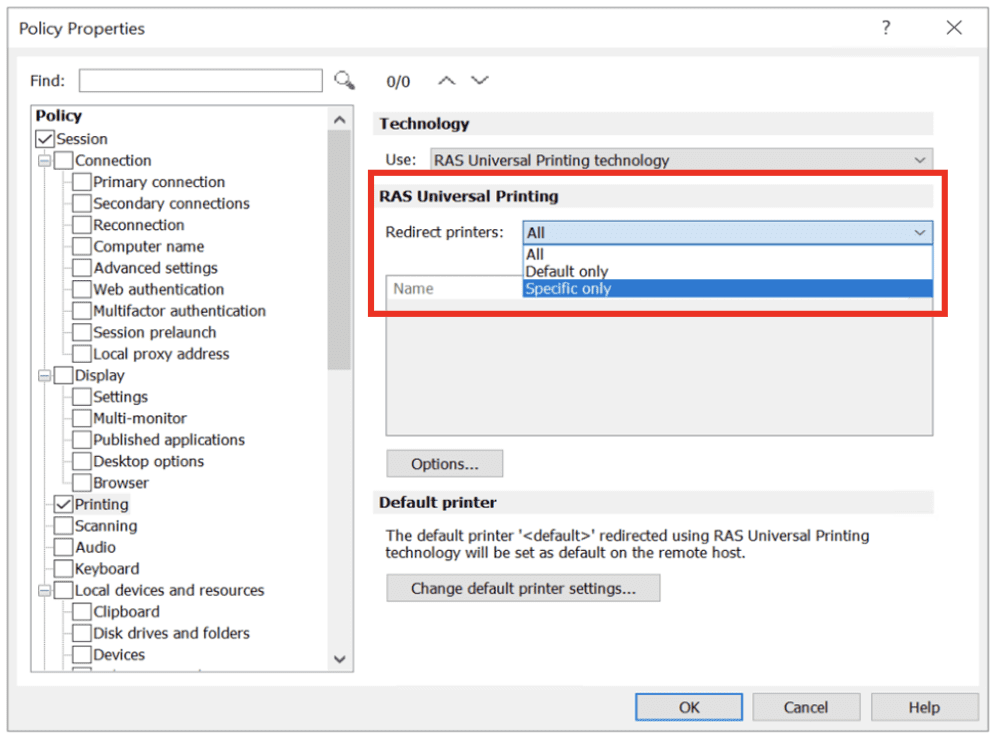
With native Microsoft RDS and Azure Virtual Desktop, you can allow client printer redirection. You have the option not to allow local printer redirection, but you cannot choose which specific printers to redirect.
Can I dynamically update the default printer?
Microsoft RDS, Azure Virtual Desktop, and Parallels RAS offer configuration options that only allow you to redirect the default printers.
If the default local printer changes during the session when using Microsoft RDS and Azure Virtual Desktop, however, it is not changed dynamically in the remote session. Users must log off and log on to have the change reflected in the remote session.
With Parallels RAS, the default local printer is updated dynamically during the remote session without the need to reconnect.
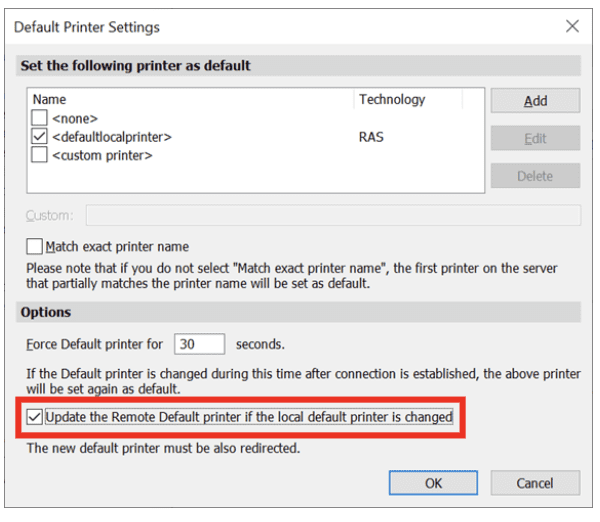
7 benefits of using Parallels RAS for universal printing
1. Dynamic printer redirection
Besides dynamically updating the default printer, Parallels RAS offers complete dynamic printer redirection.
If a user makes a change to any of the local printer preferences during a session, the redirected printer follows their changes.
This means the changes can be seen directly in the redirected printer preferences user interface, and those changes will be used for the next printing job initiated during the session.
If a user redirects all local printers and subsequently adds, deletes, or renames some printers.
In that case, the changes are reflected in the remote session accordingly, without closing and reopening the remote desktop connection.
Watch this video to see Parallels RAS dynamic printer redirection in action.
2. Controlling the naming convention of redirected printers
When using printer redirection with native RDS and Azure Virtual Desktop based on Easy Print, the name of the redirected printer has a postfix similar to “(redirected 3)”, for example.
You cannot control the naming convention that is being used—a common request to make things more transparent for the end user.
With Parallels RAS, the redirected printer name can be controlled according to a specified naming pattern.
The naming pattern can include variables like client name, client printer name, username, and session ID.


3. Speed up printer redirection at logon and at reconnect
Parallels RAS provides faster printer redirection.
With native RDS and Azure Virtual Desktop, redirection of printers can be pretty slow, typically when reconnecting to an existing (previously disconnected) session.
Parallels RAS provides a faster experience during logon as previously used printer preferences are cached on the client.
Also, pre-installed common drivers are used on the remote side for all redirected printers.
Parallels RAS printers are set to offline when a session is disconnected, and these printers go online again upon reconnecting.
That way, you speed up reconnection and avoid losing printers used by traditional Windows applications, which need all printers to be known at the start of the application.
The screenshot below shows this in action, and changing all printers from offline to ready only takes about a second to complete.
On average, this is about ten times faster than native RDS and Azure Virtual Desktop.
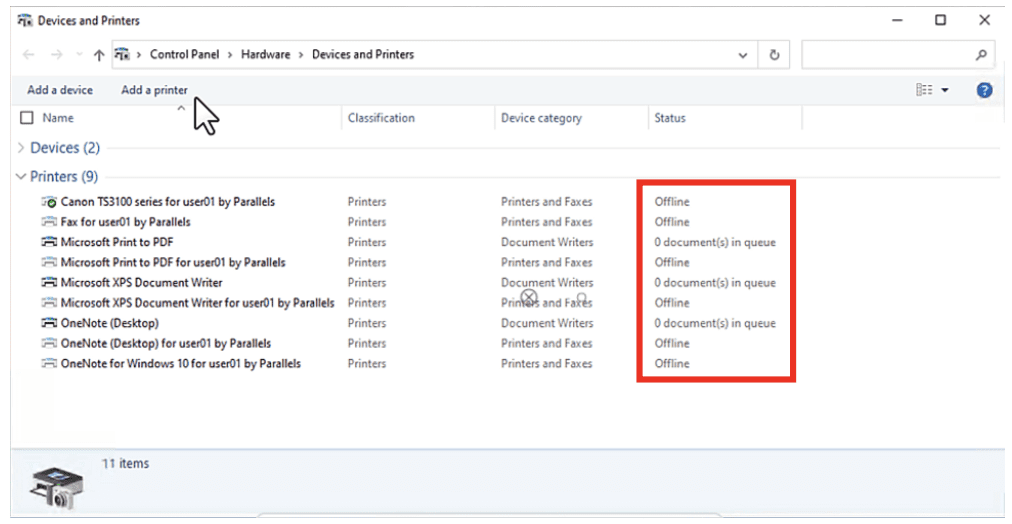
See how Parallels RAS speedy printer availability upon session reconnect compared to Native RDS and Azure Virtual Desktop.
Read on to learn how to fix the incorrect printer setup by default.
4. Broad client support and support for different printing formats
The Parallels RAS universal printing features are available for Windows, macOS, Linux, Android, iOS, and Web clients.
For macOS, there is also a pre-defined software printer that saves a printout in PDF format.
Parallels RAS universal printing supports different printing formats for printing jobs delivered to the client.
These include EMF (for Windows clients only), PDF, BMP, and RAW, where native RDS/Azure Virtual Desktop only supports XPS.
EMF is used when you need to print vector graphics or high-quality images with transparency support.
PDF is often selected when you need to share or print documents while preserving the layout and formatting across different devices and operating systems, and it can be efficient when documents contain a lot of repetitive content.
BMP is used when you require an uncompressed and lossless format for high-quality images and when the file size is not a primary concern.
Select XPS (Windows only) to create documents with complex layouts and graphics and maintain document fidelity across different platforms.
Finally, RAW is used when you need to retain the maximum amount of image data captured by a digital camera, especially in professional photography and image editing.
You can select the printing formats that best suit any given environment with Parallels RAS.
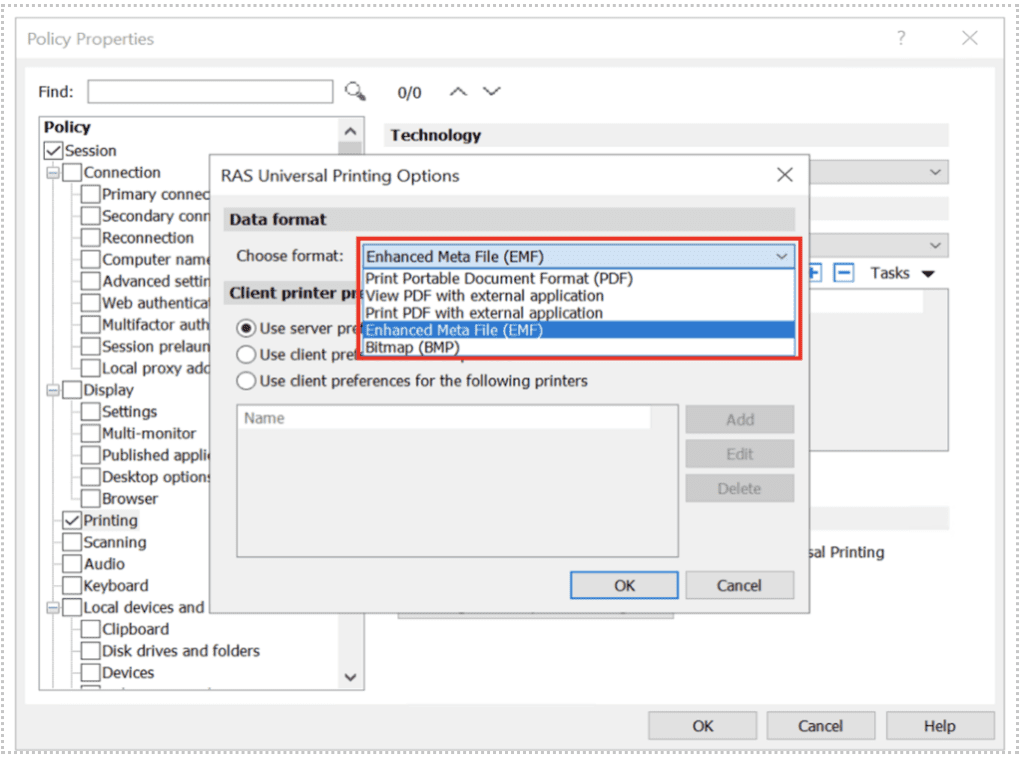
5. Fonts are delivered and cached
If a printed document references a font installed on the server.
In that case, Parallels RAS delivers that font (if it is not specified in the exclusion or pre-installed list) and the printing job to rasterize on the client side by the physical printer driver.
The delivered fonts are also cached on the client, and only their hash is transferred for cached fonts.
This avoids unneeded traffic between the server and the client and speeds up the process.
Specific fonts can also be automatically distributed to all Session Host servers and installed on the Windows client during the first connection.
This includes non-embedded fonts.
With native RDS and Azure Virtual Desktop Easy Print there is no option to print correctly with a non-embedded font if it is absent on the client side.
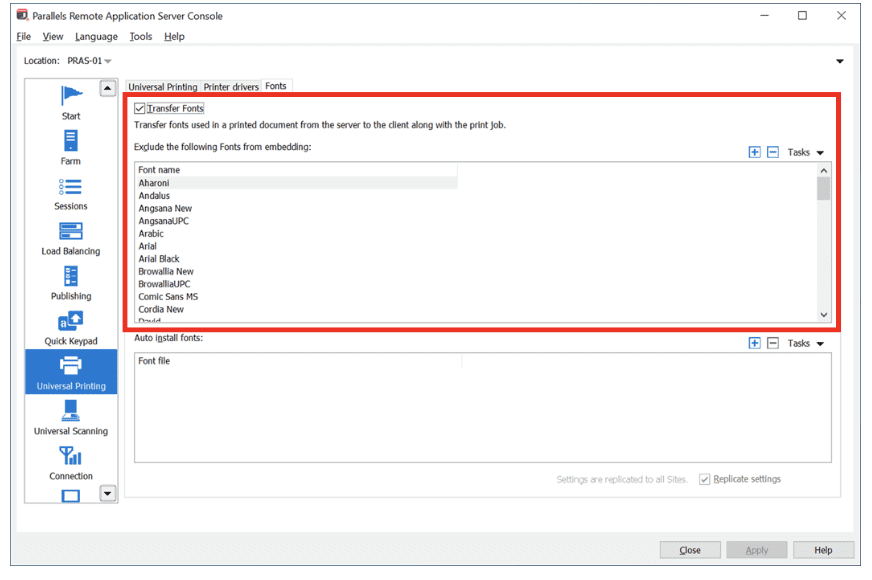
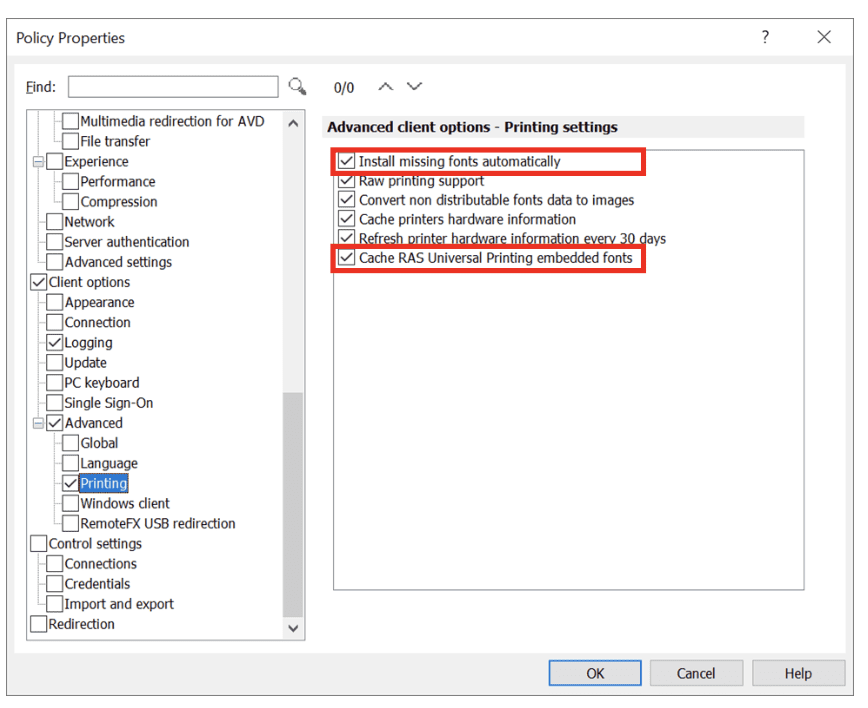
6. Avoid closing and re-opening applications to print
You’ve been in this situation before—where the printers need to be present before launching a Windows application.
You want to avoid situations where those Windows applications can’t see the printers, even though they are present.
Parallels RAS universal printing the option to launch a published application only after redirected printers appear.
That way, you don’t have to close and re-open applications to be able to print from a specific application.
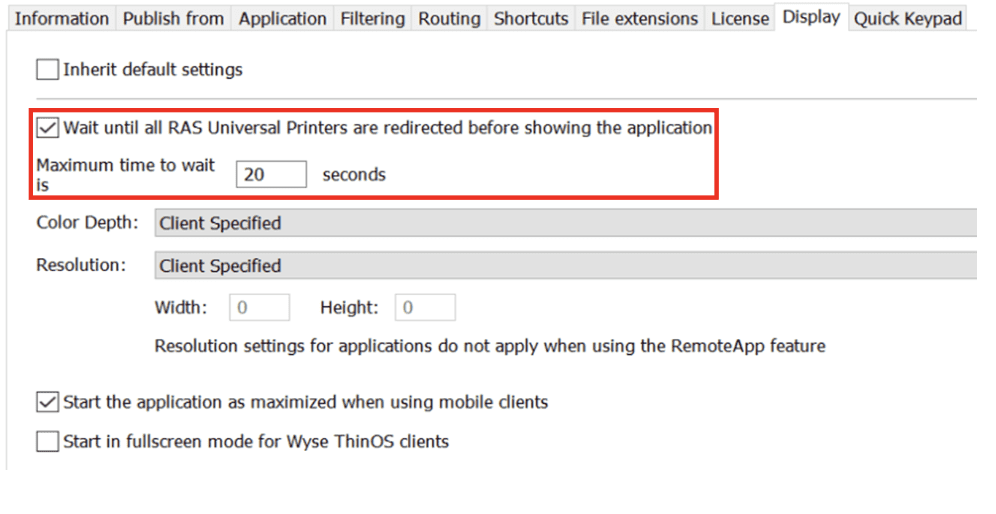
7. Faster starts to print jobs
With Parallels RAS universal printing in the EMF format, the client printer starts printing right after the first page is ready on the server.
Then, the server side sends the pages ready to print one by one.
This significantly speeds up the printing of larger multi-paged documents.
The option is configurable by setting the client-side printer advanced options and applies to printing from the web client and mobile clients as well.
Print 10x faster with Parallels RAS
“RDP printer redirection not working” issues are frustrating and belong in the past. Universal printing can be applied to Windows Server and Windows client operating systems.
The universal printing feature is included with Parallels RAS out of the box, at no additional cost.
Interested in learning more about how Parallels RAS can make IT administration more manageable for your organization? Get your free 30-day trial now!

